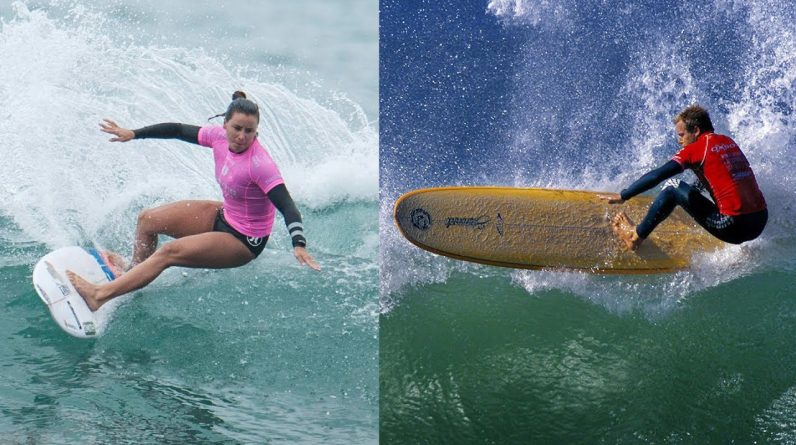
So, you’re curious about the differences between a shortboard and a longboard in surfing? Well, fret not, my eager wave-rider! In the exhilarating world of surfing, these two types of boards have distinct characteristics that cater to different surfing styles and skill levels. On one hand, you have the shortboard, a nimble and maneuverable board that allows for quick turns and tricks. On the other hand, the longboard offers stability and ease of use, making it ideal for beginners or those who prefer a more relaxed and graceful surfing experience. Join me as we ride the waves and explore the nuances of these fascinating surfboards!

This image is property of honestsurf.com.
Physical Characteristics
Dimensions
One of the key distinguishing factors between a shortboard and a longboard is their dimensions. A shortboard typically ranges in length from 5’6″ to 7’0″, while a longboard can be anywhere from 8’0″ to 10’0″ or even longer. The shorter length of a shortboard allows for quicker turns and more maneuverability, whereas the longer length of a longboard provides stability and easier wave-catching capabilities.
Shape
The shape of a surfboard greatly affects its performance in the water. Shortboards usually have a narrow and pointed nose, a thin and streamlined profile, and a rounded or square tail. This design allows for greater control and responsiveness on the wave, making it ideal for more advanced and high-performance surfing. On the other hand, longboards have a wider and rounded nose, a thicker and more buoyant body, and a rounded or square tail. This shape grants better stability and glide, enabling smooth and graceful rides, particularly in smaller waves.
Weight
Weight plays a crucial role in a surfboard’s maneuverability and overall performance. Shortboards are generally lighter due to their smaller size and thinner profile, allowing for easier transitions and sharper turns. Longboards, on the other hand, tend to be heavier due to their larger volume and increased buoyancy. This added weight helps them maintain stability and control even in choppy or windy conditions.
Volume
Volume is a significant factor in determining a surfboard’s paddling and wave-catching capabilities. Shortboards typically have lower volume, which means they sit lower in the water and require more effort to paddle. However, the lower volume also enables quicker and more vertical turns once on the wave. Longboards, with their larger volume, provide greater buoyancy, making paddling easier and wave-catching more manageable, especially in smaller or weaker waves.
Purpose and Performance
Wave Size and Type
The choice between a shortboard and a longboard often comes down to the type of waves you plan to surf. Shortboards excel in larger, steeper, and more powerful waves. Their narrow and streamlined shape allows surfers to make quick adjustments and perform more radical maneuvers in the face of big waves. Longboards, on the other hand, are better suited for smaller, mellower waves. Their larger size and floatation allow for easy wave-catching and longer rides on less powerful waves.
Agility and Maneuverability
Shortboards are renowned for their agility and maneuverability in the water. Their smaller size and streamlined profile make it easier to change directions quickly and perform tight turns. This agility is ideal for surfers looking to carve sharp, radical turns and perform advanced maneuvers such as aerials and deep barrels. Longboards, while not as nimble as shortboards, offer a unique cruising and carving experience. Their larger size and stability allow for smooth and graceful turns, perfect for those seeking a more relaxed and traditional style of surfing.
Speed and Drive
When it comes to speed and drive, shortboards are the preferred choice. Their narrow shape and refined design allow for greater speed generation and more efficient energy transfer in the wave. This speed and drive enable surfers to make powerful, high-speed maneuvers and maintain momentum in critical sections of the wave. On the other hand, longboards offer a different kind of speed. Due to their larger size and increased buoyancy, longboards can generate and maintain speed with minimal effort. This makes them perfect for cruising and gliding along the wave, providing a smoother and more relaxed surfing experience.
Stability and Balance
Stability and balance are vital aspects of any surfboard, especially for beginner and intermediate surfers. Shortboards, with their narrower and thinner profiles, tend to be less stable, requiring more skill and experience to maintain balance on the wave. Longboards, with their wider and thicker bodies, offer superior stability. Their larger surface area and added buoyancy help beginners to stay upright and gain confidence in the water. This stability is also beneficial for more experienced surfers who may want to perform nose rides or cross-step maneuvers on the longboard.
Riding Style
Traditional Longboarding
Traditional longboarding embodies the essence of the sport’s early days. It emphasizes style, grace, and long, flowing maneuvers. Longboards are the epitome of traditional longboarding, offering the stability and glide necessary for this particular riding style. Traditional longboarding involves walking up and down the board, cross-stepping, and performing smooth, sweeping turns. It is a timeless and elegant approach that showcases the surfer’s ability to harmonize with the wave.
High-Performance Longboarding
While longboards are often associated with a more laid-back style of surfing, they can also be ridden with a high-performance mindset. This style combines elements of traditional longboarding with more modern maneuvers and aggressive turns. High-performance longboarding pushes the limits of what can be achieved on a longboard, incorporating tighter and more vertical turns, noserides, and even aerial maneuvers. Surfers who prefer the flow and stability of a longboard but still crave a more dynamic and progressive style will find high-performance longboarding to be a perfect fit.
Tripping and Dropping
Tripping and dropping, also known as noseriding, is a highly specialized skill that requires a particular type of surfboard – the classic longboard. This riding style involves maneuvering to the front of the board and perching the toes over the nose, known as “hanging ten.” This maneuver enables the surfer to ride effortlessly on the tip of the board while maintaining control and balance. Tripping and dropping is a true display of skill and style, showcasing the timeless artistry of longboarding.
Progressive Shortboarding
Progressive shortboarding is all about pushing the boundaries of what is possible on a surfboard. This style involves performing radical and aggressive maneuvers, including powerful turns, aerial tricks, and deep tube rides. Shortboards are the go-to choice for progressive shortboarding due to their enhanced maneuverability and responsiveness. Surfers who prefer an adrenaline rush and enjoy the challenge of conquering big and powerful waves will find progressive shortboarding to be the perfect fit.
Power Surfing
Power surfing is a style that prioritizes strong, flowing maneuvers and maximizing speed and power in every wave. It involves performing powerful carves, vertical turns, and executing critical maneuvers in the critical sections of the wave. Both shortboards and longboards can be used for power surfing, with shortboards offering quicker and more radical turns while longboards provide the advantage of maintaining speed and power in smaller or weaker waves. Power surfing is favored by surfers who appreciate the thrill of riding with force and intensity.
Wave Catching
Paddling Efficiency
Efficient paddling is crucial for catching waves and positioning oneself in the lineup. The design and shape of a surfboard can significantly impact paddling efficiency. Shortboards have a narrower profile, which reduces surface area in the water, making paddling more challenging but requiring less effort once on the wave. Longboards, with their wider noses and greater surface area, provide excellent paddling efficiency, allowing surfers to easily catch waves and get into position.
Early Entry
Early entry into a wave is essential to maximize ride time and catch the best part of the wave. Shortboards excel in early entry due to their smaller size and ability to fit into tight pockets. With their maneuverability and responsiveness, shortboards allow surfers to quickly drop in and set up for maneuvers. Longboards, although not as quick off the mark, offer an advantage in earlier entry due to their buoyancy and stability. The larger size and increased volume enable longboarders to paddle into waves with ease, allowing for longer rides and earlier positioning.
Control
Control is a key factor when it comes to wave-catching. Shortboards offer greater control once on the wave due to their ability to respond quickly and easily to weight distribution and transitions. This control enables surfers to execute precise maneuvers and maintain balance in critical sections of the wave. Longboards, with their added stability and buoyancy, provide excellent control, especially in smaller or weaker waves. They allow surfers to maintain balance and manipulate the board’s position to maximize ride time and control their speed.
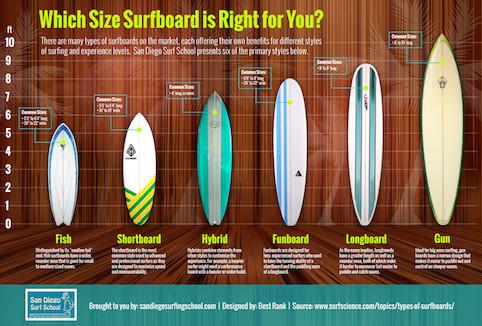
This image is property of www.sandiegosurfingschool.com.
Turns and Maneuvers
Bottom Turn
The bottom turn is the foundation of every successful maneuver. It involves transitioning from the face of the wave to the bottom, setting up for the next maneuver or generating speed. Shortboards are well-suited for executing powerful and critical bottom turns due to their maneuverability and responsiveness. Their narrower tails and increased rocker provide optimal drive and control in the turn. Longboards, although not as quick to respond, can still perform smooth and flowing bottom turns because of their stability and ability to maintain speed throughout the turn.
Cutback
Cutbacks are a classic maneuver used to redirect the board’s momentum back towards the wave’s power source. Shortboards excel in executing sharp and aggressive cutbacks due to their responsiveness and ability to quickly change direction. Their shorter length allows for tighter turns, making it easier to rebound off the wave’s face. Longboards, while not as nimble, can still perform cutbacks with finesse and style. The larger size and added stability of the longboard provide a more drawn-out and flowing cutback style, adding elegance to this fundamental maneuver.
Snap
A snap is an explosive and dynamic maneuver that involves a quick and powerful turn back towards the breaking part of the wave. Shortboards are the preferred choice for executing snaps due to their ability to generate speed and make rapid adjustments. Their responsive nature allows surfers to transfer weight and power through the tail, resulting in an explosive snap maneuver. Longboards, while not as quick off the mark, can still perform snaps with precision and style. They provide the advantage of maintaining speed and control during the maneuver, resulting in a flowing and graceful snap.
Floater
A floater is a maneuver performed on the face of a breaking wave, where the surfer rides along the top of the wave without losing momentum. Shortboards are ideal for executing floaters due to their ability to quickly generate speed and maintain control in critical sections of the wave. Their maneuverability allows for precise positioning, ensuring the surfer safely rides over the collapsing lip. Longboards, with their increased buoyancy and stability, are also capable of performing floaters, offering a unique and graceful glide along the wave’s face.
Aerials
Aerial maneuvers, also known as airs, are impressive displays of athleticism and creativity in surfing. Shortboards are the go-to choice for performing aerials due to their lightweight and responsive nature. Their smaller size and ability to generate speed quickly make it easier to launch off the wave and execute complex aerial maneuvers. Longboards, while not traditionally associated with aerials, can still be used to perform more stylish and traditional airs. Surfers with sufficient skill and experience can use the longboard’s stability and drive to launch into the air, showcasing a unique blend of old-school and modern surfing.
Learning Curve
Beginner-Friendly
For novice surfers, a longer and wider board is generally more beginner-friendly. Longboards, with their increased stability and flotation, provide an excellent platform for beginners to learn the fundamentals of surfing. The added buoyancy makes paddling easier, catching waves more manageable, and maintaining balance more forgiving. Longboards’ forgiving nature helps beginners develop confidence and progress at a faster rate. However, shortboards are not typically recommended for beginners due to their smaller size and greater maneuverability, which can make learning to surf more challenging and frustrating.
Intermediate Level
As surfers progress to the intermediate level, they usually develop more experience, control, and a wider skill set. This progress allows them to consider transitioning to a shorter board, such as a funboard or a mid-length board. These boards offer a blend of the stability and paddling ease of a longboard with the maneuverability and performance characteristics of a shortboard. Intermediate surfers can experiment with different board shapes and sizes to find the right balance between stability and performance, enabling them to continue advancing their skills.
Advanced Skills
Advanced surfers possess exceptional wave-reading abilities, precise timing, and an array of maneuvers in their repertoire. At this level, surfers can confidently ride shortboards and explore the boundaries of high-performance surfing. The responsiveness and maneuverability of a shortboard become crucial elements in executing radical maneuvers, powerful turns, and aerial tricks. Advanced surfers often have the skills and experience necessary to make split-second decisions and adapt their style to various wave conditions.
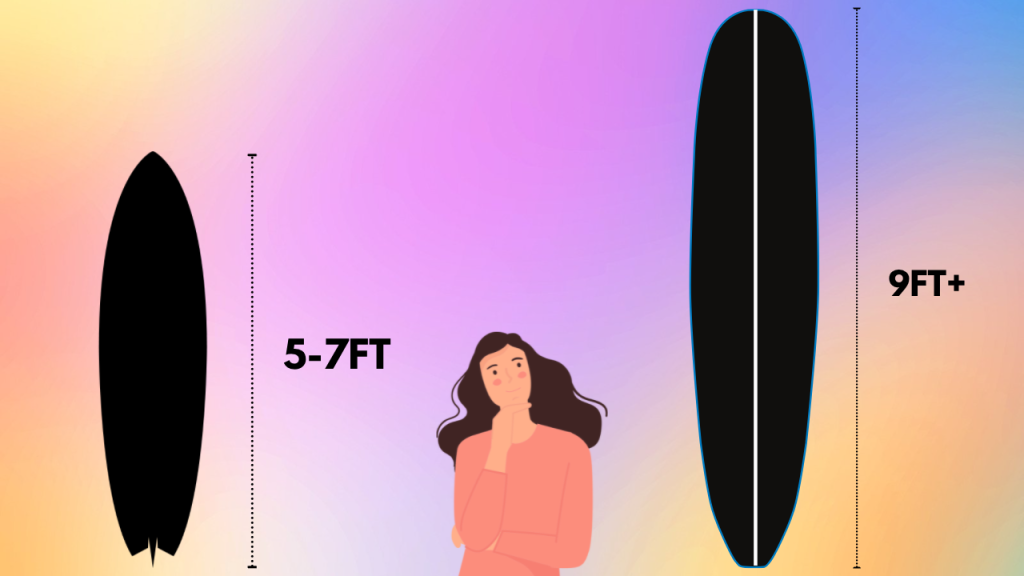
This image is property of houseofsurf.co.
Equipment Price Range
Shortboard Costs
The cost of a shortboard can vary significantly depending on the brand, materials used, and the board’s overall quality. Entry-level or budget-friendly shortboards typically range from $300 to $600. These boards are usually mass-produced and made from less expensive materials, making them more affordable for beginners. Mid-range shortboards, which offer better performance and higher quality, generally fall between $600 and $1,000. Custom-made or high-performance shortboards, crafted by renowned shapers with top-of-the-line materials, can cost anywhere from $1,000 to $2,500 or more, depending on specific customization requests.
Longboard Costs
Similar to shortboards, the cost of a longboard can vary depending on various factors such as brand, materials, and craftsmanship. Entry-level longboards typically start around $400 to $800. These boards often use less expensive materials and are more budget-friendly for beginners. Mid-range longboards range from $800 to $1,500 and offer higher performance and better quality construction. Custom longboards, hand-shaped by experienced craftsmen with premium materials, can cost upwards of $1,500 to $3,500 or more, depending on the design, artwork, and specific customization requests.
Popularity
Competitive Surfing
In the realm of competitive surfing, shortboards dominate the scene. The high-performance capabilities of shortboards allow surfers to execute the advanced maneuvers and radical turns required for competitive success. The majority of professional surfing events and contests are focused on high-performance shortboarding, attracting the best surfers from around the world. While longboard competitions exist, they tend to focus more on traditional and stylish surfing rather than the progressive and aggressive nature of shortboard competitions.
Surfing Communities
Surfing communities are diverse and encompass surfers of all levels and preferences. While shortboarding is often associated with a more cutting-edge and progressive style, longboarding maintains a strong presence within these communities. Longboarding communities emphasize a more relaxed and harmonious approach to surfing, appreciating the artistry and elegance of traditional longboarding. Both shortboarding and longboarding communities promote inclusivity, camaraderie, and the love of riding waves, regardless of the chosen board style.
Professional Surfers
Professional surfers play a significant role in popularizing various styles and aspects of surfing. Shortboard professionals garner the most attention due to their high-performance skills and participation in globally recognized events such as the World Surf League (WSL) Championship Tour. These professional shortboarders inspire aspiring surfers with their speed, power, and progression. However, there is also a growing number of professional longboarders who specialize in traditional longboarding, showcasing the unique style and grace of this discipline. These professionals contribute to the popularity and recognition of longboarding within the surfing community.
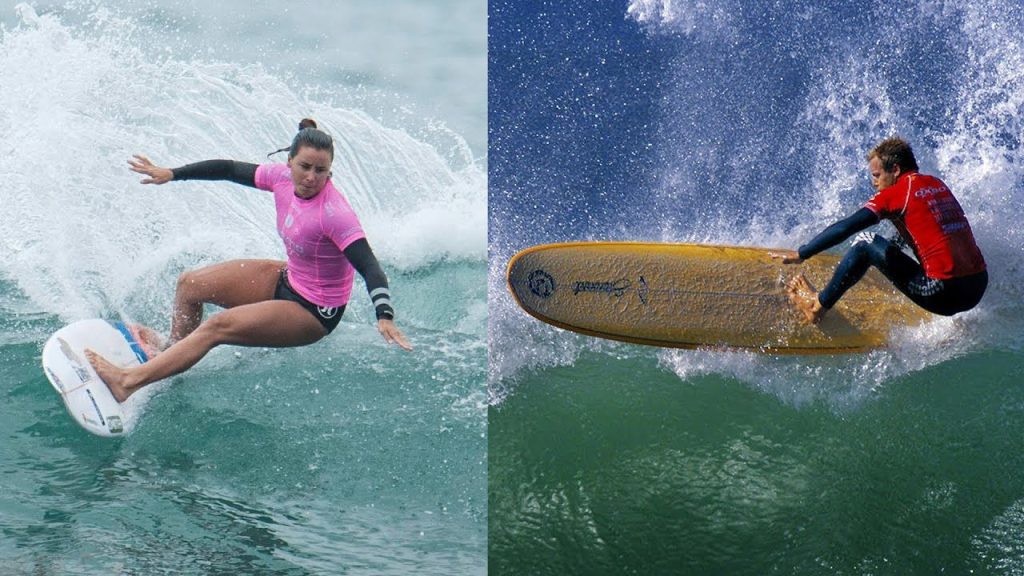
This image is property of i.ytimg.com.
Growing Trends
Retro-Inspired Designs
The world of surfing has experienced a resurgence in retro-inspired designs, paying homage to the sport’s roots and its golden eras. Retro-inspired surfboards often feature wider outlines, more volume, and classic color schemes reminiscent of earlier decades. These boards offer a blend of traditional style and modern performance characteristics, allowing surfers to experience the nostalgia of surfing’s past while still enjoying the benefits of contemporary board design.
Hybrid Boards
Hybrid boards combine elements from different types of surfboards to create versatile and adaptable platforms. These boards often blend the stability and wave-catching capabilities of longboards with the maneuverability and high-performance characteristics of shortboards. Hybrid boards can cater to a wide range of skill levels and wave conditions, making them popular choices for surfers who want a single board that can handle different styles and conditions.
Surfing Styles
While shortboarding continues to dominate the surfing scene, alternative surfing styles are gaining popularity. Styles like retro-style logging, high-performance longboarding, and finless surfing are all attracting surfers who seek a different experience and want to push the boundaries of what is traditionally considered “surfing.” These alternative styles offer unique challenges and allow surfers to experiment with different board designs and techniques, adding new layers of creativity and diversity to the surfing community.
Personal Preference
Surfer’s Skill Level
When selecting a surfboard, personal skill level is a crucial consideration. Beginner surfers should opt for a longboard, as their stability and ease of wave-catching provide an ideal learning platform. As surfers progress and develop more experience and proficiency, shorter boards can be introduced, offering more maneuverability and high-performance capabilities. Expert surfers can choose boards tailored to their specific preference, allowing them to maximize their skills and push the limits of their surfing style.
Surfer’s Physical Attributes
Physical attributes, such as height, weight, and strength, can influence the choice of surfboard. Shortboards, with their smaller size and lower volume, require more effort from the surfer to paddle and catch waves. They are better suited to surfers who are lighter in weight and possess greater strength and agility. Longboards, with their larger volume and increased buoyancy, are a better option for surfers who are heavier or taller, as they provide easier wave-catching and better stability.
Surfer’s Riding Goals
Riding goals play a significant role in selecting the appropriate surfboard. Surfers seeking a traditional and relaxed style may gravitate towards longboards, as they offer stability, glide, and the ability to perform elegant maneuvers. For those pursuing a high-performance approach, shortboards are the go-to choice, providing the maneuverability and responsiveness required for explosive turns and aerial tricks. Surfing goals can range from mastering classic longboarding techniques to pushing the boundaries of progressive shortboarding, and the choice of surfboard should align with these aspirations.
Surfer’s Experience
Experience is a determining factor in choosing the right surfboard. Novice surfers will benefit from the stability and ease of use provided by longboards. These boards allow beginners to focus on the fundamentals of surfing and gain confidence in the water. As surfers develop more experience, they can transition to shorter boards that offer greater maneuverability and performance capabilities. Experienced surfers can experiment with various board types and designs to find the combination that complements their skills and style.
In conclusion, the difference between a shortboard and a longboard in surfing is significant and goes beyond their physical characteristics. Each type of surfboard offers unique advantages and suits different riding styles, wave conditions, skill levels, and personal preferences. Whether you choose a shortboard for its high-performance capabilities or a longboard for its stability and glide, the joy of riding waves remains at the heart of every surfer’s journey. Ultimately, the best surfboard is the one that allows you to connect with the ocean, express yourself, and experience the thrill of riding the perfect wave.
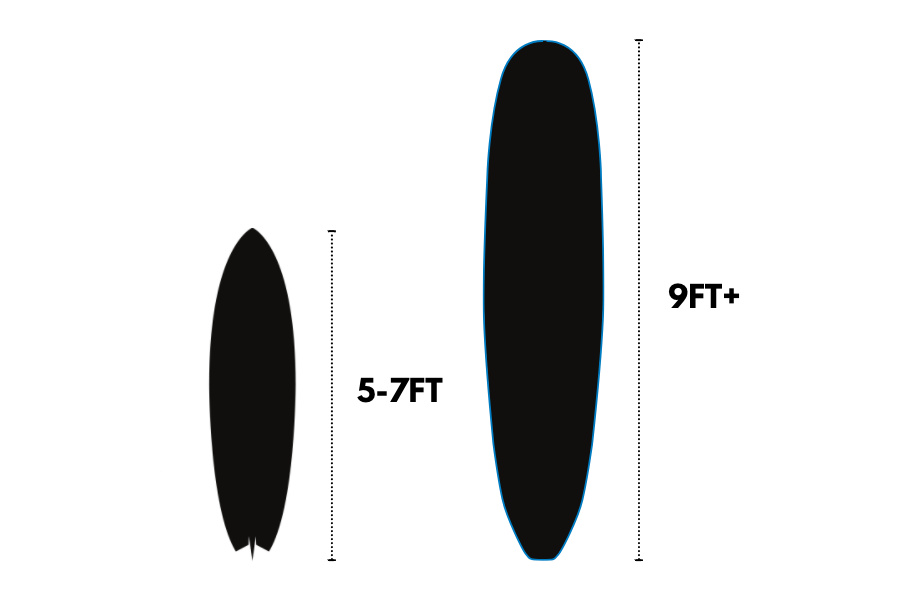
This image is property of houseofsurf.co.






